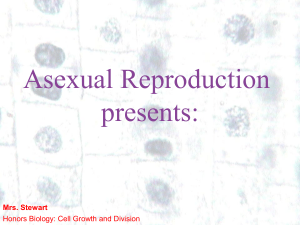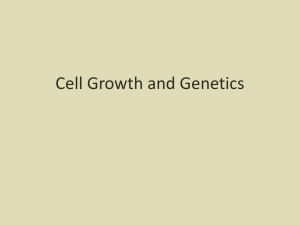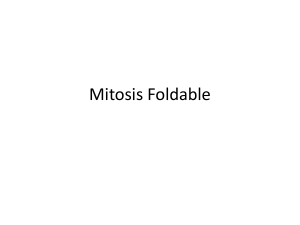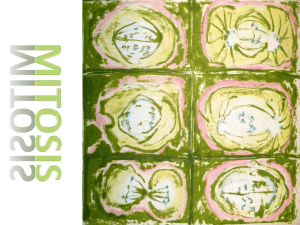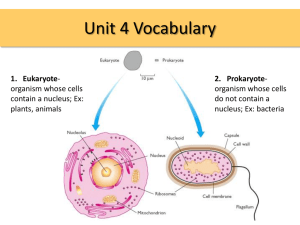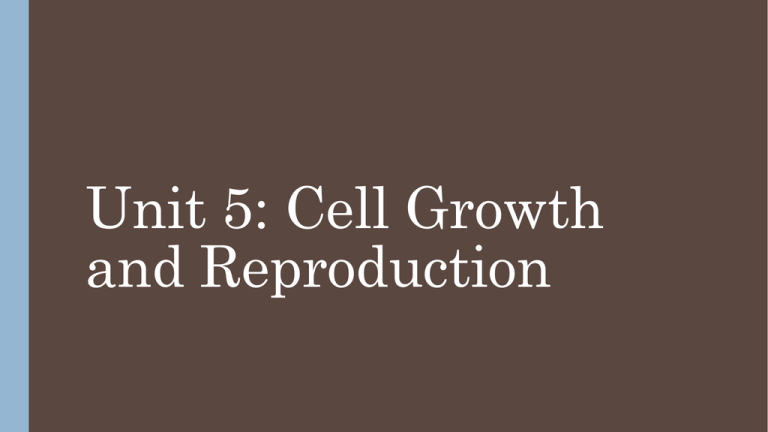
Unit 5: Cell Growth
and Reproduction
Bell Ringer
•
If you work part-time and only earn $100/week, then your gas allowance is
pretty minimal. You need to make a decision to buy a car that is fuel
efficient (Let’s face it – you don’t want to have to pay to go to work!). This
Ford Focus gets excellent gas mileage compared to the Ford F150. Write
down one key reason for this difference in gas mileage.
LEQ – Describe factors that influence
cell size.
I. Factors Limiting Cell Size
•
A. Diffusion
•
B. DNA Content
•
C. Surface area-to-volume ratio
A. DIFFUSION
•
1. Certain materials needed for the survival of the cell can only enter through
diffusion
a. Ex. Waste, Carbon Dioxide, Oxygen
•
2. Diffusion is only efficient over a short distance
a. Imagine a cell that’s 20 cm! It would have to wait several months to receive the
above listed molecules
B. DNA CONTENT
• 1.
• 2.
Most cells have only 1 nucleus
DNA in the nucleus makes RNA and releases it to
the cytoplasm where it directs the production of
enzymes
a. Lack of enzymes = Lack of cellular metabolism
b. Some large cells have compensated by having
multiple nuclei
C. Surface Area-to-Volume Ratio
• 1. If you double the size of a cell:
a. It has 8x as much volume
b. Gives rise to 8x as much waste and need for
nutrients
c. Impossible for diffusion to keep up with the
cellular demands!
Quick Review: Write your response
below
•
Explain why cells need to be small and why having large cells would cause
serious complications.
Bell Ringer
•
Think about the cells that make up your muscles, skin, and eyes (somatic
cells). Each day, these cells need to be made to replace damaged and worn
out ones. You also make gametes (sex cells). The process for making each
type of cell has its similarities, but also its difference.
•
With the person next to you, brainstorm 1 key difference between making a
sperm cell and muscle cell.
LEQ – Describe the three stages of the
cell cycle: interphase, nuclear division,
and cytokinesis.
I. Cell Division
•
A. Process by which cells reproduce themselves
1. Gametes – Sex cells (sperm and egg)
a. Haploid – 1 copy of chromosomes (half)
2. Somatic cells – any cell other than sex cells
(muscles, liver, skin, etc.)
b. Diploid – 2 copies of chromosomes (double)
•
B. Types of Cell Division
1. Prokaryotes
a. Binary Fission
2. Eukaryotes
a. Cell Cycle
1. Interphase, Mitosis (PMAT), and Cytokinesis
2. Meiosis
•
C. Chromosome Types
1. Sex chromosomes
a. Chromosomes that determine the sex of an organism
b. X or Y chromosomes
2. Autosomes
a. All of the other chromosomes in an organism
b. Ex. Hair color, eye color, hemophilia
II. Binary Fission in
Prokaryotes
•
A. Division of a prokaryotic cell into two
offspring cells
1. DNA is copied and results in two identical cells
2. Cell grows to twice its original size.
3. Cell membrane grows inward until it meets
pinching of and forming two identical cells
II. Binary Fission in Prokaryotes
Quick Review: Write response below
•
Following binary fission, how do the daughter cells compare to the parent
cell? Are the resulting cells diploid or haploid?
•
What type of cells use this process?
III. Cell Cycle in Eukaryotes
•
A. Three main stages of Cell Cycle
1. Interphase – growth period of time where
cell activities are carried out
Most of cell’s life spent here
2. Mitosis – process of nuclear division,
followed by cytoplasm division
3. Cytokinesis – cytoplasm division
1. Interphase
•
A. G1 Phase (Think “growth 1”) Normal cell activity and growth
•
B. S Phase (Think “synthesis”) DNA Synthesis
•
1. Metabolism – Making ATP
2. Cell growth – doubles in size
3. New organelles produced – mitochondria, ribosomes, centrioles
4. Maintenance and repair
1. Chromosomes are replicated (ready for mitosis)
2. Make new proteins
3. Synthesizing new organelles
4. Conducting photosynthesis (autotrophs)
5. Storing excess glucose (starch, glycogen)
C. G2 Phase (Think “growth 2”) Cell prepares of mitosis
1. Final preparation before cell division (mitosis)
2. Mitosis Stages
•
A. Prophase
•
B. Metaphase
•
C. Anaphase
•
D. Telophase
•
**THINK PMAT**
•
E. Results 2 diploid offspring cells that are genetically identical to
original cell
A. Prophase
•
1. First and longest stage of mitosis
a. Chromatin in the nucleus becomes visible chromosomes
(chromosomes condense)
b. Nucleus disappears
c. Centrioles separate and start moving to opposite poles
d. Chromatin, which was copied during interphase forms 2
complete sets of chromosomes called sister chromatids
e. Spindle fibers
1. From between pairs of centrioles
2. Attach to each chromosome by a kinetochore
B. Metaphase
• 1.
• 2.
2nd stage of mitosis
Kinetochore fibers attached to chromosome’s
centromere causes chromosomes line up in the
middle of the cell
a. THINK: META MIDDLE
C. Anaphase
• 1.
Third stage of mitosis
• 2.
Chromosomes separate at the
centromere
THINK: “ANA” AWAY/APART
• 3.
Each sister chromatid begins to move to
opposite ends of the cell
D. Telophase
•
1. Fourth stage of mitosis
•
2. Sister chromatids have pulled apart
a. One copy of each chromosome at one end of cell and
another copy at other end
•
3. Spindle apparatus disappears
•
4. Nuclear membrane reforms around each set of
chromosomes and nucleoli reappear
•
5. Chromosomes uncoil
•
6. Two daughter cells are formed
a. Each new cell has a complete set of chromosomes
b. Humans – 46 total chromosomes per cell (23 pairs)
Mitosis Review
3. Cytokinesis
• A.
Cytoplasm and all organelles are
divided as plasma membrane pinches
inward (cleavage furrow) to form two new
daughter cell SEPARATE from each other
Cell plate forms in plant cells, not
cleavage furrow
• B. Nucleus reappears
• C. Interphase begins again
• D. END RESULT: 2 genetically identical
diploid daughter cells to the parent
Quick Review: Write response below
•
Put the following stages of the cell cycle in the correct order. Circle and label the stages that
are part of interphase, mitosis, and cytokinesis.
•
Anaphase
•
Cytokinesis
•
G1 phase
•
G2 phase
•
Metaphase
•
Prophase
•
S phase
•
Telophase
•
How many cells are produce from one parent cell? Are they identical or different? Are the
chromosomes in each cell diploid or haploid?
IV. Control of Cell Division
• A.
Cell division in eukaryotes is controlled
by many proteins.
• B.
Control occurs at three main
checkpoints.
1. G1
2. G2
3. Mitosis
IV. Control of the Cell Cycle Continued
•
C. Cellular enzymes and genes play a key
role in checking and balancing cell division
1. Tells cells when to divide/stop
2. Proto-oncogene – regulates cell growth,
division and the ability for cells to adhere to one
another
a. Mutation of the proto-oncogene causes an oncogene
b. ONCOGENE = UNCONTROLLED CELL
DIVISION
•
D. Contact inhibition – cell to cell
communication between neighboring
cells…stops the cellular division
1. Eliminates an over-production of certain types
of cells within the body.
V. CANCER – A Loss of Control
•
A. Cancer – an uncontrolled dividing of cells
1. Caused by a change in one or more of the genes synthesizing enzymes to
control the cell cycle (genetic factor)
2. Cancer genes are often expressed when environmental conditions change
(environmental factor)
•
B. Carcinogen
1. Any substance that can induce or promote cancer
a. Most carcinogens are mutagens
1. Cause mutation within the cell
2. Known carcinogens include:
a. Chemicals in tobacco smoke
b. Radiation
c. UV light
d. Certain viruses
VI. Cells Regain Control
• A.
Some genes act as brakes to suppress cancer
expression
• B.
Tumor-suppressor genes – code for proteins
that prevent cell division from occurring too often
1. To get cancer, these tumor suppressor genes (all
3 of them) must be damaged
Quick Review: Write response below
•
What changes would have to occur throughout the cell cycle to cause cancer
cells to be produced?
Bell Ringer
•
This tiger (top) does not look like most other tigers
(bottom). Write down some key differences of this
tiger compared to others you may have seen.
Brainstorm what could have caused such changes to
occur.
VII. Meiosis: Formation of Haploid Cells
•
A. Meiosis – cell division that produces 4 haploid cells
1. Occurs in sex cells (gametes –sperm or egg cells) of sexual reproducing organisms
•
B. Stages of Meiosis
1. Interphase (S phase) where chromosome replication is included in meiosis
REMEMBER – Interphase is not part of MITOSIS
2. Meiosis I – DNA REDUCTION
a. Prophase I
b. Metaphase I
c. Anaphase I
d. Telophase I
3. Meiosis II – SISTER CHROMATID SEPARATION
a. Prophase II
b. Metaphase II
c. Anaphase II
d. Telophase II
VII. Meiosis I Stages
•
A. Prophase I
1. Homologous (same) chromosomes pair and become tetrads (two chromosomes or
four chromatids). Crossing-over between homologous chromosomes occurs at this
stage.
2. Crossing-over – exchange of genetic material between homologous
chromosomes
THIS IS WHY YOU DON’T LOOK EXACTLY LIKE YOUR BROTHER/SISER
•
B. Metaphase I (Remember: Meta Middle)
1. After crossing over occurs, homologous chromosomes line-up along the equator
•
C. Anaphase I
1. Whole chromosomes separate from the tetrad formation and move to opposite
sides of the cell. Each chromosome still has two sister chromatids
•
D. Telophase I
1. Nuclear membrane forms around each set of chromosomes
2. 2 cells formed each cell now has one set of chromosomes and is haploid (n)
3. NO DNA REPLICATION BEFORE MEIOSIS II
Metaphase
Anaphase
Telophase
Meiosis I
VIII. Meiosis II (similar to
mitosis)
•
A. Prophase II
1. Sister chromatids become short and thick
2. Spindle apparatus forms and chromosomes condense
•
B. Metaphase II
1. Chromosomes migrate to the center of the nucleus and lineup in the cell’s middle
•
C. Anaphase II
1. Sister chromatids are pulled apart by microtubules to
opposite poles
•
D. Telophase II
1. Nuclear envelope forms around each set of chromosomes
•
E. Cytokinesis
1. The cells divide to create four haploid cells that are
genetically different
2. Humans – 23 total chromosomes per cell
Meiosis II
Quick Review: Write response below
•
What occurs during Meiosis I that allows for genetic variation to exist within the
newly forming cells?
•
Within what specific stage does this occur?
•
How many cells are produced in meiosis?
•
Are they diploid or haploid?
IX. Differences Between Meiosis and
Mitosis
MEIOSIS
Mitosis
•
Only occurs in sex cells
•
Occurs in all body (somatic) cells
•
Chromosome number reduced to half
•
Chromosome number stays same
HAPLOID (n)
DIPLOID (2n)
•
4 genetically different daughter cells
•
2 genetically identical daughter cells
•
Two cell sub-divisions: Meiosis I and
Meiosis II each with 4 phases
•
One cell division with 4 phases
•
Crossing over occurs
•
No crossing over
During Prophase I
X. Gamete Production Through Meiosis
A. Spermatogenesis
•
1. Creates 4 sperm cells
B. Oogenesis
•
1. Creates 1 ootid (egg cell) with 3
polar bodies (non-functional)
XI. Asexual Reproduction
•
A. Production of offspring from one parent without the union of gametes
•
B. Occurs only by mitosis
XII. Sexual Reproduction
•
A. Production of offspring through meiosis and the
union of gametes
•
B. Offspring genetically different due to genetic
recombination
1. Parts of chromatids can be exchanged (crossing over)
2. Homologous pairs separate
XIII. Disorders during Meiosis
•
A. Nondisjunction
1. Process in which homologous chromosomes or sister chromatids fail to separate during
meiosis
2. Can occur in anaphase of meiosis I or II (chromosomes are not pulled AWAY during
ANAPHASE)
a. Results in gametes with abnormal numbers of chromosomes
•
B. Examples:
1. Down Syndrome (Trisomy 21) – extra copy of chromosome 21
2. Patau Syndome (Trisomy 13) – extra 13th chromosome copy
a. Polydactyly
•
C. Risk of nondisjunction increases as female ages
1. Higher rates of Down Syndrome after woman turns 30 years old
•
D. Karyotype - shows number and appearance of chromosomes in nucleus
XIV. Chromosome Organism Numbers
•
A. Each species has a characteristic
number of chromosomes per cell
1. Not same number for each species
Quick Review: Write response below
•
What term describes when chromosomes fail to separate?
•
What phase of meiosis does this occur in?
•
Give one genetic disorder due to this.
•
Does man’s best friend (a dog) have the same number of chromosomes as
humans?
Bell Ringer
•
If you have full blooded brothers and sisters, do you all have the same hair,
same eyes, same height? List the similarities and differences between you.
What phase of meiosis has allowed for these changes to occur? What traits
about you are similar to your parents?
•
Similarities and differences to siblings:
•
Phase of meiosis:
•
Similar to parents:
LEQ – Explain how genetic
information is inherited.
I. DNA Inheritance
•
A. DNA Replication
1. Molecular mechanism of inheritance
2. Occurs during S phase of mitosis or meiosis
II. DNA Structure
•
A. Polymer made from nucleotides (monomers)
bound together
•
B. Nucleotide
1. Phosphate group
2. 5-carbon sugar
3. Nitrogenous base
a. Adenine (A)
b. Guanine (G)
c. Thymine (T)
d. Cytosine (C)
4. Held together by H-bonds
•
C. Double Helix
1. 2 strands of DNA bonded together that run in
opposite directions
2. Backbones: Sugar-Phosphate on outside
a. Nitrogenous bases on inside
III. DNA: Base Pairing
•
A. Complementary Base Pairing
1. 2 strands of DNA bound together by H-bonds between bases and nucleotides
2. Pairings:
a. A – T
b. C – G
IV. DNA Replication
•
A. Semi-conservative – one old strand of DNA is conserved, while a new
strand is made from a template from the old strand
•
B. During replication:
1. Double helix separates Each DNA strand is template for new DNA strand
(Helicase unzips DNA)
2. New strand built by adding complementary nucleotide (A-T, C-G) then sealed
back up
3. Genetic information conserved because of base pairing rules NEW DNA
EXACT COPY OF ORIGINAL DNA
Quick Review: Write response below
•
Explain what is meant when people say DNA replication is semi-conservative? How
does this maintain the same genetic information?
V. Genetic Code and Gene
Transmission/Expression
•
A. Genetic Code - contained in specific order of four base pairs in DNA
•
B. Rules of Gene Transmission and Expression:
1. Genes – elements of DNA responsible for observed traits
a. Eukaryotes – large linear chromosomes
b. Specific location on chromosome
2. Chromosome – very long continuous DNA double-helix
1. Humans – 23 PAIRS of chromosomes in somatic (body) cells (46 total)
a. Each pair represent homologous chromosomes (one from mom and one from dad)
3. Allele – different version of a gene
1. Because two copies of a gene can have different nucleotide sequence
2. Ex. Attached (f) and free earlobes (F) different alleles for a gene
a. Homozygous – two copies (2 alleles) of a gene that are identical
1. Ex. FF
b. Heterozygous – two different alleles for a gene
1. Ex. Ff
3. Genotype – genetic make up (Ex. FF, Ff, ff)
4. Phenotype – appearance and physical expression of genes (Ex. attached earlobes, free
earlobes)
VI. Genetic Variation
•
A. Can occur when alleles are randomly sorted during meiosis
•
B. Since each offspring receives a different combination of alleles from the
parent organisms, phenotypic diversity results
Quick Review: Write response below
•
Explain how alleles are responsible for producing genetic diversity among
offspring. Why is genetic variation within alleles not possible for asexual
reproducing organisms?



